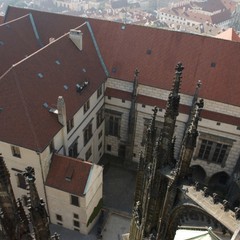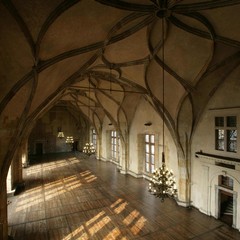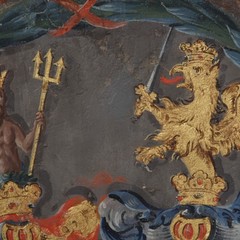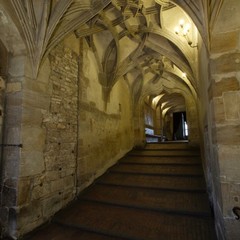Old Royal Palace
The original residence building, mostly wooden, was built at Prague Castle already at the turn of the 9th and 10th century. Its exact location is not documented. It was prince Soběslav in the 12th century who had a stone Romanesque palace built right next to a new fortification wall. Remains of it have been preserved in the underground till the present times. The palace was adjoined on its eastern side by All Saints' Chapel, which was consecrated in 1185.

The platform stairlift is temporarily out of service. We apologize for the inconvenience.
In the first half of the 14th century, the king and emperor Charles IV enlarged the Romanesque building and so a Gothic palace with a vaulted interior for state purposes and a band of arcades on its northern side came to be. During the reign of his son Wenceslas IV, two perpendicular wings were added and All Saints' Chapel was reconstructed.
The palace was deserted for entire eighty years of the stormy 15th century. After 1483, the king Vladislav Jagiello returned to Prague Castle and commenced the last large-scale reconstruction of the palace. The magnificent solemn Vladislav Hall was added to it and when designing it, the architect Benedikt Ried combined the art of the Late Gothic with elements of the newly arriving Renaissance style. The perpendicular palace wing named after Vladislav's son Ludvig is also the work of B. Ried. After the succession of the Habsburgs to the Bohemian throne, the interiors of the Old Royal Palace were used for coronation festivities and diets and as conference rooms, offices and depositories. New dwelling quarters were built to the west of the palace, in the southern part of the Castle complex. After the catastrophic fire which occurred in 1541, the Diet and All Saints' Church were rebuilt.
The Theresian Wing originated in the course of the reconstruction of the Castle in the 18th century. During the 20th century it has been subjected to several reconstructions. In 1993 it was adapted for exhibitions of creative art.
The Vladislav Hall

From the 16th century, the Vladislav Hall served particularly royal state purposes. It was the scene of coronation festivities and banquets, knights' tournaments and markets with artistic and luxurious goods. The Vladislav Hall still partly fulfils the state function: the elections of the president of the Czech Republic used to take place there and ceremonial gatherings connected with important days in the life of this country are held there still.
Neighbouring on the Vladislav Hall is the Diet, which through the furnishings of its interior affords an idea of the way in which the proceedings of the Diet took place after 1627, and also All Saints' Church. From the south-western corner of the Vladislav Hall a portal leads to the Ludwig Wing with the offices of the Czech Chancellery. In 1618, its second room witnessed the beginning of the uprising of the Czech Estates when two governors and a scribe were thrown into the Castle ditch from its window. The uprising of the Czech Estates was the first conflict of the Thirty Years' War (1618 - 1648).
The observation gallery on the southern wall of the Vladislav Hall affords a beautiful view of the Garden on the Ramparts and of Prague.
Nowadays, the exit from the Vladislav Hall is formed by the Riders' Staircase, built originally to enable knights to enter the hall on horseback in order to take part in the jousting competitions held in it. The staircase is vaulted with a complicated Late Gothic rib vault.
All Saints' Church
The All Saints' Church was built by Petr Parler on the site of the Romanesque palace chapel, also consecrated to All Saints. According to old sources, the church was magnificently decorated in the manner of Sainte Chapelle in Paris. However, after the great fire of 1541, only its peripheral walls remained.
In the course of its renewal, the church was extended as far as the facade of the Vladislav Hall and during later modifications it was connected with it by means of a portal.
Old Royal Palace is part of the circuit ticket.
The Theresian Wing is adapted for exhibitions of art.
All Saints's Church is open to the public only when religious services take place in it.










